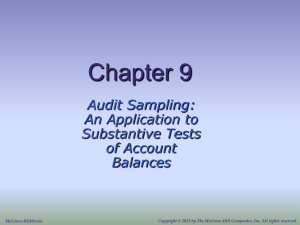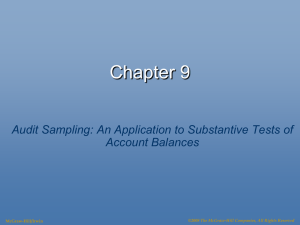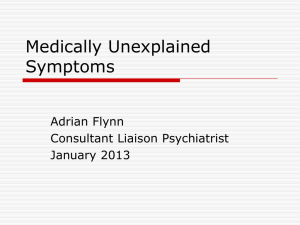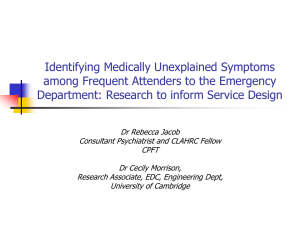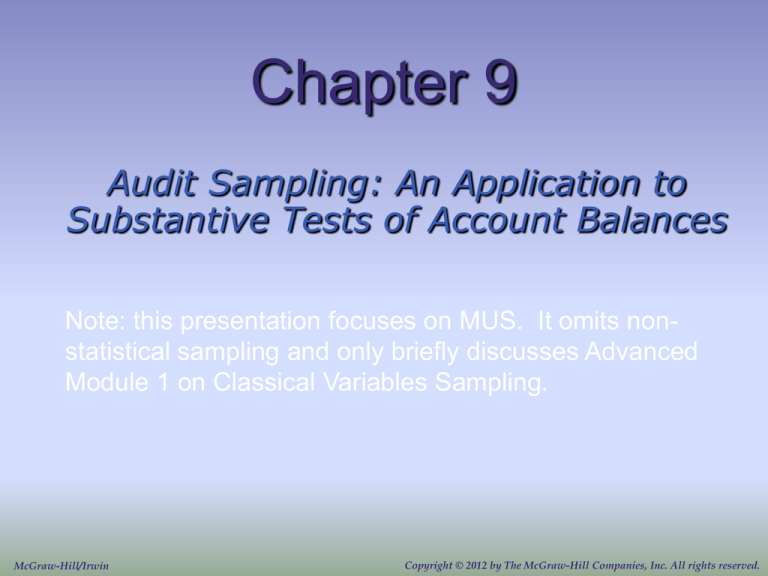
Chapter 9
Audit Sampling: An Application to
Substantive Tests of Account Balances
Note: this presentation focuses on MUS. It omits nonstatistical sampling and only briefly discusses Advanced
Module 1 on Classical Variables Sampling.
McGraw-Hill/Irwin
Copyright © 2012 by The McGraw-Hill Companies, Inc. All rights reserved.
LO# 1
Substantive Tests of Details of Account Balances
Sometime, auditors use Monetary Unit Sampling
(MUS), sometimes Variables (or Classical Variables)
Sampling, and sometimes other methods of statistical
inference.
Our text discusses only MUS in the main part of the
chapter. MUS is also known as dollar-unit sampling or
probability-proportional-to-size sampling.
Classical Variables Sampling is discussed in Module 1
(which we do not study in depth).
Thus, our focus of study in Chapter 9 is MUS. It is
arguably the most important method. Assume I am
referring to MUS throughout this presentation unless I
state otherwise.
9-2
LO# 1
Substantive Tests of Details of Account Balances
Some statistical concepts in Chapter 8 also apply to
Chapter 9. In fact, when using the textbook to
determine the right sample size, we use Table 8-5.
Take a look now at Table 8-5:
1. Desired confidence level – similar to Ch. 8
2. Tolerable Misstatement – analogous to Tolerable
Deviation Rate of Ch. 8
3. Estimated misstatement – analogous to Expected
Population Deviation Rate of Ch. 8
However, there are some things very different in Ch. 9.
A fourth factor is very important for determining the right
sample size:
4. Population – number of dollars in an account balance
9-3
Illustration of the MUS approach
The
next 2 slides demonstrate (as
does p. 312 of the 8th edition of your
text) the MUS approach
They do not demonstrate correct
MUS
They merely demonstrate an
approach somewhat like MUS
LO# 1
Illustration slide 1: Substantive Tests of
Details of Account Balances
Consider the following information about the inventory
account balance of an audit client:
Book value of inventory account balance
Book value of items sampled
Audited value of items sampled
Total amount of overstatement observed in audit sample
$ 3,000,000
$
100,000
98,000
$
2,000
The ratio of misstatement in the sample is 2%
($2,000 ÷ $100,000)
Applying the ratio to the entire population produces a best
estimate of misstatement of inventory of $60,000.
($3,000,000 × 2%)
9-5
LO# 1
Illustration slide 2: Substantive Tests of
Details of Account Balances
The results of our audit test depend upon
the tolerable misstatement associated
with the inventory account. If the tolerable
misstatement is $50,000, we cannot
conclude that the account is fairly stated
because our best estimate of the
projected misstatement is greater than
the tolerable misstatement.
9-6
LO# 2
Monetary-Unit Sampling (MUS)
MUS uses attribute-sampling theory to
express a conclusion in dollar amounts rather
than as a rate of occurrence. It is commonly
used by auditors to test accounts such as
accounts receivable, loans receivable,
investment securities, and inventory.
9-7
LO# 2
Monetary-Unit Sampling (MUS)
MUS estimates the percentage of monetary
units in a population that might be misstated
and then multiplies this percentage by an
estimate of how much the dollars are
misstated.
9-8
LO# 2
Monetary-Unit Sampling (MUS)
Advantages of MUS
1. When the auditor expects no misstatement, MUS
usually results in a smaller sample size than classical
variables sampling.
2. When applied using the probability-proportional-to-size
procedure, MUS automatically results in a stratified
sample.
3. MUS does not require the user to make assumptions
about the distribution of misstatements.
9-9
LO# 2
Monetary-Unit Sampling (MUS)
Disadvantages of MUS
1. The selection of zero or negative balances generally
requires special design consideration.
2. The general approach to MUS assumes that the
audited amount of the sample item is not in error by
more than 100%.
3. When more than one or two misstatements are
detected, the sample results calculations may
overstate the allowance for sampling risk.
9-10
Terms for MUS determination of right
sample size: Text vs. ACL
Monetary Unit Sampling
– The ACL GUI calls this Monetary
Desired Confidence Level
– ACL calls this Confidence
Tolerable Misstatement (%)
– ACL calls this Materiality
Expected Misstatement (%)
– ACL calls this Expected Total Errors
Sampling Interval
– ACL calls this Interval
Steps in MUS
LO# 2
Steps in MUS Application
Planning
1. Determine the test objectives.
2. Define the population characteristics:
• Define the population.
• Define the sampling unit.
• Define a misstatement.
3. Determine the sample size, using the following inputs:
• The desired confidence level or risk of incorrect acceptance.
• The tolerable misstatement.
• The expected population misstatement.
• Population size.
Performance
4. Select sample items.
5. Perform the auditing procedures.
• Understand and analyze any misstatements observed.
Evaluation
6. Calculate the projected misstatement and the upper limit on misstatement.
7. Draw final conclusions.
9-12
LO# 2
Steps in MUS
Steps in MUS Application
Planning
1. Determine the test objectives.
2. Define the population characteristics.
• Define the population.
• Define the sampling unit.
• Define a misstatement.
MUS is usually used to test the reasonableness of
assertions about a financial statement amount (i.e.,
is the dollar amount materially correct).
9-13
LO# 2
Steps in MUS
Steps in MUS Application
Planning
1. Determine the test objectives.
2. Define the population characteristics.
• Define the population.
• Define the sampling unit.
• Define a misstatement.
For MUS the population is defined as the
number of dollars in an account balance,
such as accounts receivable, investment
securities, or inventory.
9-14
LO# 2
Steps in MUS
Steps in MUS Application
Planning
1. Determine the test objectives.
2. Define the population characteristics.
• Define the population.
• Define the sampling unit.
• Define a misstatement.
An individual dollar represents
the sampling unit.
9-15
LO# 2
Steps in MUS
Steps in MUS Application
Planning
1. Determine the test objectives.
2. Define the population characteristics.
• Define the population.
• Define the sampling unit.
• Define a misstatement.
A misstatement is the difference between monetary
amounts in the company’s records and amounts
supported by audit evidence.
For example, the company records that a customer
owes it $10,000 as of the fiscal year end; the auditor
reviews the support documentation and determines only
$6000 was owed. That would be a $4000 misstatement.
9-16
LO# 2
Steps in MUS
Steps in MUS Application
3. Determine the sample size, using the following inputs:
• The desired confidence level or risk of incorrect acceptance.
• The tolerable misstatement.
• The expected population misstatement.
• Population size.
Factor
Relationship
to Sample Size
Desired confidence level
Direct
Tolerable mistatement
Inverse
Expected mistatement
Direct
Population size
Direct
Change
in Factor
Lower
Higher
Lower
Higher
Lower
Higher
Lower
Higher
Effect on
Sample
Decrease
Increase
Increase
Decrease
Decrease
Increase
Decrease
Increase
9-17
LO# 2
Sample Selection
Steps in MUS Application
Performance
4. Select sample items.
5. Perform the auditing procedures.
Evaluation
6. Calculate the projected misstatement and the upper limit on misstatement.
7. Draw final conclusions.
The auditor selects a sample for MUS by using
probability-proportional-to-size selection. This requires
(either manually or by having software like ACL do it)
calculation of the sampling interval. Manual calculation
of the sampling interval is book value (pre-audit
recorded amount of the account or population) divided
by the sample size.
9-18
Sample Selection (continued)
Each
dollar in the population has an
equal chance of being selected and
items or “logical units” greater than
the interval will always be selected.
However, no item will be selected
more than once.
– Consequently, the number of items
selected, which is the actual size of the
sample, almost always is smaller than
the formal sample size.
LO# 2
Steps in MUS
Assume a client’s book value of accounts receivable is $2,500,000, and the
auditor determined a sample size of 93. The sampling interval will be
$26,882 ($2,500,000 ÷ 93). The random number selected is $3,977, so the
auditor would select the following items for testing:
Account
1001 Ace Emergency Center
1002 Admington Hospital
1003 Jess Base, Inc.
1004 Good Hospital Corp.
1005 Jen Mara Corp.
1006 Zippy Corp.
1007 Green River Mfg.
1008 Bead Hospital Centers
•
•
1213 Andrew Call Medical
1214 Lilly Heather, Inc.
1215 Janyne Ann Corp.
Total Accounts Receivable
Balance
$
2,350
15,495
945
21,893
3,968
32,549
2,246
11,860
•
•
26,945
1,023
$ 2,500,000
Cumulative
Dollars
$
2,350
17,845
18,790
40,683
44,651
77,200
79,446
91,306
•
•
2,472,032
2,498,977
$ 2,500,000
Sample
Item
$
3,977
(1)
30,859
(2)
57,741
(3)
84,623
•
•
(4)
2,477,121
$ 3,977
26,882
$ 30,859
(93)
9-20
LO# 2
Steps in MUS
Steps in MUS Application
Performance
4. Select sample items.
5. Perform the auditing procedures.
Evaluation
6. Calculate the projected misstatement and the upper limit on misstatement.
7. Draw final conclusions.
After the sample items have been selected,
the auditor conducts the planned audit
procedures on the logical units containing
the selected dollar sampling units.
9-21
LO# 2
Steps in MUS
Evaluation
6. Calculate the projected misstatement and the upper limit on misstatement.
7. Draw final conclusions.
The misstatements detected in the sample must be
“projected to the population,” which means
determining the allowance for sampling risk.
The process for determining the allowance for
sampling risk is more complex for MUS than it was in
Ch. 8. It involves two components:
Basic Precision: general sampling risk; and
Sampling risk associated with each misstatement
found where the item was (pre-audit) less than the
sample interval.
9-22
Comparison of textbook terms vs. ACL
terms for MUS results evaluation
Monetary
Unit Sampling
– ACL: Monetary
Sampling
Interval
– ACL: Interval
Misstatements
or Differences
– ACL: Errors
Upper
Misstatement Limit (the
analog to Ch. 8’s CUDR)
– ACL: Upper Error Limit
Evaluation of the results in MUS
The next slide discusses, using the example
below, Basic Precision. Subsequent slides
show the allowance for sampling risk related to
specific misstatements found where the item
misstated was (pre-audit or book value) less
than the sampling interval, and then show all
the information put together.
New Example Information
Book value
Tolerable misstatement
Sample size
Desired confidence level
Expected amount of misstatement
Sampling interval
$ 2,500,000
$ 125,000
93
95%
$
25,000
$
26,882
LO# 3
Steps in MUS
Basic Precision using the Table
If no misstatements are found in the sample,
the best estimate of the population
misstatement would be zero dollars.
Number of
Errors
0
1
2
3
4
90% Confidence Level
Misstatement
Incremental
Factor
Increase
2.3
3.9
1.6
5.3
1.4
6.6
1.3
7.9
1.3
95% Confidence Level
Misstatement
Incremental
Factor
Increase
3.0
4.7
1.7
6.2
1.5
7.6
1.4
9.0
1.4
$26,882 × 3.0 = $80,646 upper misstatement limit
9-25
LO# 3
Steps in MUS
Misstatements Detected
In the sample of 93 items, the following misstatements
were found:
Customer
Good Hospital Corp.
Marva Medical Supply
Learn Heart Centers
Axa Corp.
Book Value
$
21,893
6,705
15,000
32,549
Audit Value
$
18,609
4,023
0
30,049
Difference
$
3,284
2,682
15,000
2,500
Tainting
Factor
Diff/BV
0.15
0.40
1.00
NA
Because the Axa balance of$3,284
$32,549
greater =than
÷is$21,893
15%the
interval of $26,882, no sampling risk is added. Since all
the dollars in the large accounts are audited, there is no
sampling risk specifically associated with large accounts.
9-26
LO# 3
Steps in MUS
Upper Misstatement Limit
We compute the upper misstatement limit by calculating basic
precision and ranking the detected misstatements based on
the size of the tainting factor from the largest to the smallest.
Tainting
Factor
1.00
1.00
0.40
0.15
Customer
Basic Precision
Learn Heart Centers
Marva Medical
Good Hospital
Add misstatments greater
than the sampling interval:
Axa Corp.
NA
Sample
Interval
$ 26,882
26,882
26,882
26,882
Projected
Misstatement
NA
26,882
10,753
4,032
26,882
2,500
Upper Misstatement Limit
(0.15 × $26,882 × 1.4 = $5,645)
95% Upper
Limit
3.0
1.7 (4.7 - 3.0)
1.5 (6.2 - 4.7)
1.4 (7.6 - 6.2)
Upper
Misstatement
$
80,646
45,700
16,130
5,645
$
2,500
150,621
9-27
LO# 3
Steps in MUS
Steps in MUS Application
Evaluation
6. Calculate the projected misstatement and the upper limit on misstatement
7. Draw final conclusions.
In our example, the final decision is
whether the accounts receivable balance
is materially misstated or not.
Compare Tolerable Misstatement
to the Upper Misstatement Limit. If
the Upper Misstatement Limit is
greater than the Tolerable
Misstatement, we conclude that
the balance is materially misstated.
9-28
LO# 3
Steps in MUS
In our example, the upper misstatement limit of $150,621
is greater than the tolerable misstatement of $125,000, so
the auditor concludes that the accounts receivable
balance is materially misstated.
When faced with this situation, the auditor may:
1. Increase the sample size.
2. Perform other substantive procedures.
3. Request the client adjust the accounts receivable balance.
4. If the client refuses to adjust the account balance, the
auditor would consider issuing a qualified or an adverse
opinion.
9-29
LO# 5
Classical Variables Sampling
There are some situations where MUS
does not work well. Thus, auditors turn
to other statistical methods. The most
common method they turn to is classical
variables sampling (also called variable
sampling).
9-30
LO# 5
Classical Variables Sampling
Advantages
1. When the auditor expects a large number of
misstatements or differences between book and
audited values, this method will normally result in
smaller sample size than MUS.
2. The techniques are effective for both
overstatements and understatements.
3. The selection of zero balances generally does not
require special sample design considerations.
9-31
LO# 5
Classical Variables Sampling
Disadvantages
1. Does not work well when little or no misstatement
is expected in the population.
2. To determine sample size, the auditor must
estimate the standard deviation of the audit
differences. If the estimate is sufficiently wrong,
the statistical results could be completely wrong.
9-32
End of Chapter 9
9-33

